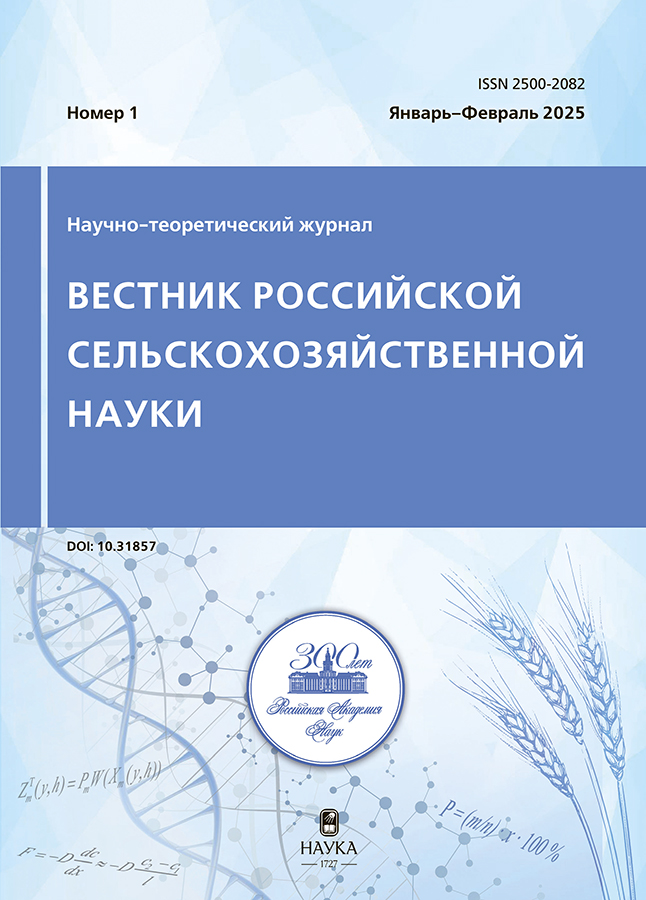Monitoring the epizootic state of apiaries in the Tyumen Region and other regions of Russia
- Authors: Domatskaya T.F.1, Domatsky А.N.1, Dolnikova T.Y.1, Zinatullina Z.Y.1, Stolbova V.V.1
-
Affiliations:
- All-Russian Scientific Research Institute of Veterinary Entomology and Arachnology – Branch of Federal State Instution Federal Research Centre Tyumen Scientific Centre of Siberian Branch of the Russian Academy of Sciences
- Issue: No 1 (2025)
- Pages: 74-77
- Section: Veterinary entomology
- URL: https://transsyst.ru/2500-2082/article/view/686158
- DOI: https://doi.org/10.31857/S2500208225010171
- EDN: https://elibrary.ru/CRVAVJ
- ID: 686158
Cite item
Abstract
Purpose of the study: continue monitoring apiaries in the Tyumen region and other regions of Russia for contamination of bee colonies with pathogens causing invasions and infections. Research objectives: to study the spread of varroatosis, nosematosis and tropilelapsosis in apiaries of the Tyumen region and other regions of Russia. A total of 181 samples of bees and brood from bee colonies in 21 apiaries, located in the Altai territory, Irkutsk, Tyumen regions and in Dagestan were studied. The studies were conducted in accordance with the “Methodological guidelines for laboratory studies of honey bee nosematosis”, “Methodological guidelines for differential diagnostics of Nosema apis and Nosema ceranae”, “Methodological recommendations for studying means and methods of combating the Varroa mite”, “Methodological guidelines for diagnostics of bee tropilelapsosis”, “Standard methods for Tropilaelaps”. Analysis of the results showed, that the bee colonies have a high level of infection of bees with Varroa. destructor mites (55.5–83.3%), microsporidia N. ceranae (23.1–83.3%), while the degree of infection with nosema ranged from 30.5 to 128 million spores per bee.In the studied pathological material from the Dagestan , Varroa destructor and Tropilaelaps spp. mites were found. The level of infestation of brood cells with the found mites was 55.5%, with Tropilaelaps mites registered in 14.5% of the studied cells. Larval stages of both mites were also found, indicating active reproduction and development of these ectoparasites in bee brood. For the first time in the Tyumen region, Tropilaelaps mercedesae mites, the causative agents of tropilelapsosis in bees, have been found and identified.
Full Text
About the authors
T. F. Domatskaya
All-Russian Scientific Research Institute of Veterinary Entomology and Arachnology – Branch of Federal State Instution Federal Research Centre Tyumen Scientific Centre of Siberian Branch of the Russian Academy of Sciences
Author for correspondence.
Email: varroa54@mail.ru
PhD in Biological Sciences
Russian Federation, TyumenА. N. Domatsky
All-Russian Scientific Research Institute of Veterinary Entomology and Arachnology – Branch of Federal State Instution Federal Research Centre Tyumen Scientific Centre of Siberian Branch of the Russian Academy of Sciences
Email: varroa54@mail.ru
PhD in Biological Sciences
Russian Federation, TyumenT. Y. Dolnikova
All-Russian Scientific Research Institute of Veterinary Entomology and Arachnology – Branch of Federal State Instution Federal Research Centre Tyumen Scientific Centre of Siberian Branch of the Russian Academy of Sciences
Email: varroa54@mail.ru
PhD in Chemical Sciences
Russian Federation, TyumenZ. Y. Zinatullina
All-Russian Scientific Research Institute of Veterinary Entomology and Arachnology – Branch of Federal State Instution Federal Research Centre Tyumen Scientific Centre of Siberian Branch of the Russian Academy of Sciences
Email: varroa54@mail.ru
PhD in Biological Sciences
Russian Federation, TyumenV. V. Stolbova
All-Russian Scientific Research Institute of Veterinary Entomology and Arachnology – Branch of Federal State Instution Federal Research Centre Tyumen Scientific Centre of Siberian Branch of the Russian Academy of Sciences
Email: varroa54@mail.ru
Junior Researcher
Russian Federation, TyumenReferences
- Brandorf A.Z., Sohlikov A.B. Tropilelapsoz pchel – novaya ugroza rossijskomu pchelovodstvu // Rossijskij zhurnal «Problemy veterinarnoj sanitarii, gigieny i ekologii». 2023. № 2 (46). S. 217–226. https://doi.org/ 10.36871/vet.san.hyg.ecol.202302014
- Zinatullina, Z.Ya., Zhigilyova O.N., Tokarev Yu.S. Metodicheskie nastavleniya po differencial’noj diagnostike Nosema apis i Nosema ceranae u medonosnoj pchely (Apis mellifera L.) // Sb. nauch. tr. VNIIVEA, Tyumen’. 2011. Vyp. 51. S. 286–300.
- Metodicheskie ukazaniya po laboratornym issledovaniyam na nozematoz medonosnyh pchel / GUV MSH SSSR. M. 25.04.1985.
- Metodicheskie rekomendacii po izucheniyu sredstv i priemov bor’by s kleshchom varroa / Otdelenie veterinarii Rossel’hozakademii. M. 08.06.2020.
- Metodicheskie ukazaniya po diagnostike tropilelapsoza pchel, utverzhdeny Glavnym upravleniem veterinarii Minsel’hoza SSSR 14.05.1981.
- Anderson D.L., Morgan M.J. Genetic and morphological variation of Bee parasitic Tropilaelaps mites (Acari: Laelapidae): New and re-defined species // Experimental and Applied Acarology. 2007. 43. РР. 1–24.
- Anderson D.L., Roberts John M. K. Standard methods for Tropilaelaps mites Research // Journal of Apicultural Research, 2013. (52:4). РР. 1–16. https://doi.org/10.3896/IBRA.1.52.4.21
- Brandorf A.Z, Ivoilovaa M M., Yanezb O. et al. First report of established mite populations, Tropilaelaps mercedesae in Europe // Journal of Apicultural research. 2024. № 5. PP. 1–3. https://doi.org//10.1080/00218839.2024.2343976
- Joharchi O., Stolbova V. The first report on the ectoparasitic genus Tropilaelaps (Acari: Mesostigmata: Laelapidae) in Russia // Persian J. Acarol. 2023. Vol. 13. No. 3. PP. 513–516. https://doi.org/10.22073/pja.v13i3.85545
Supplementary files










